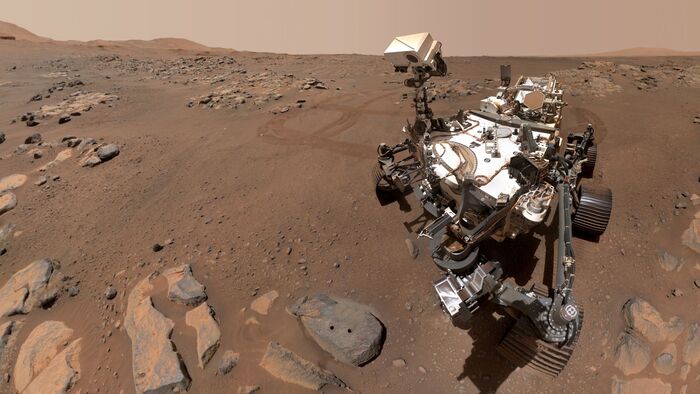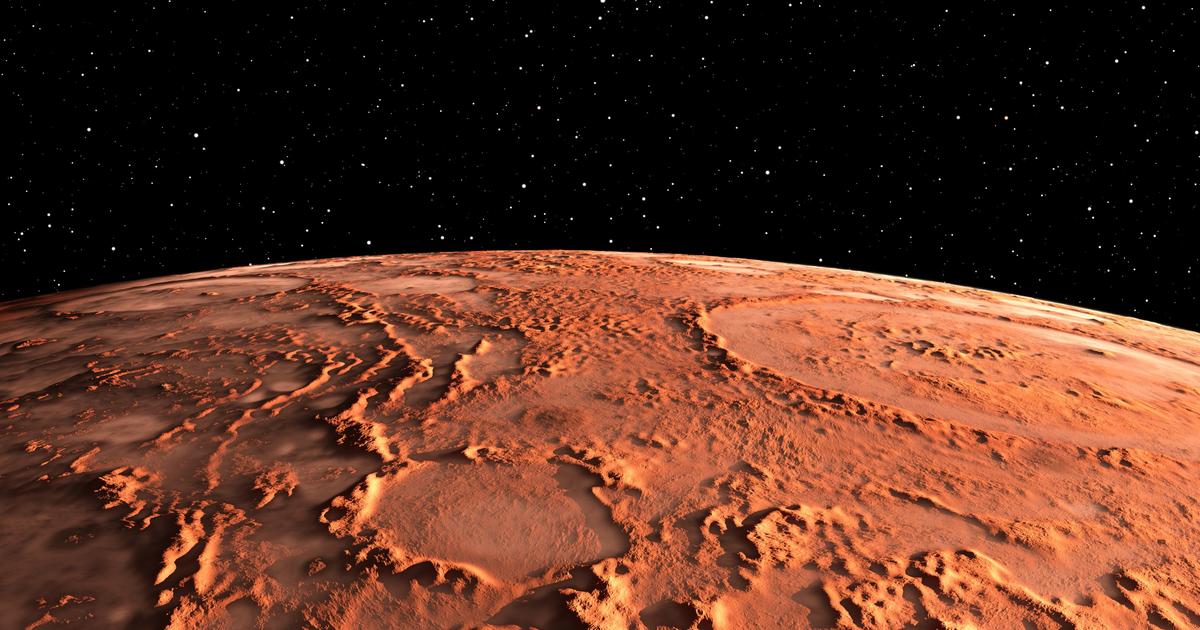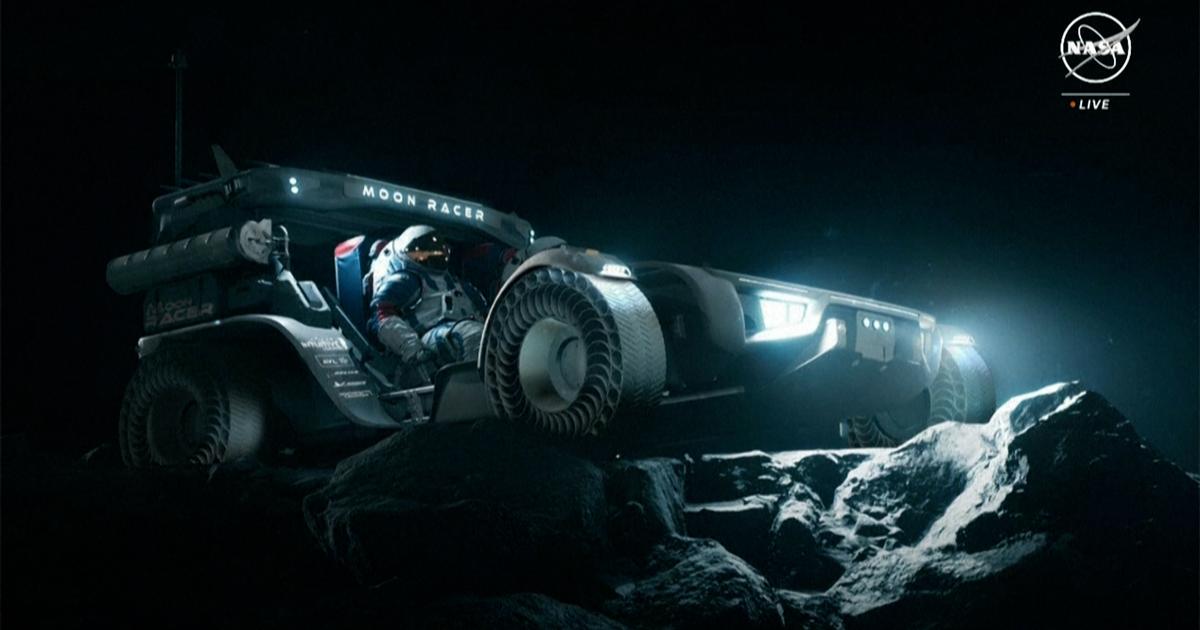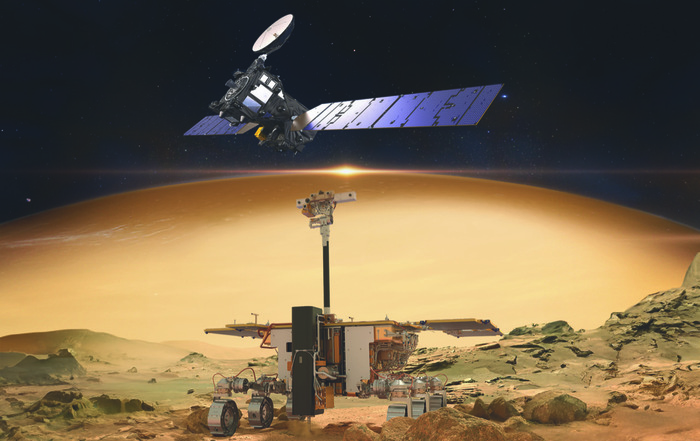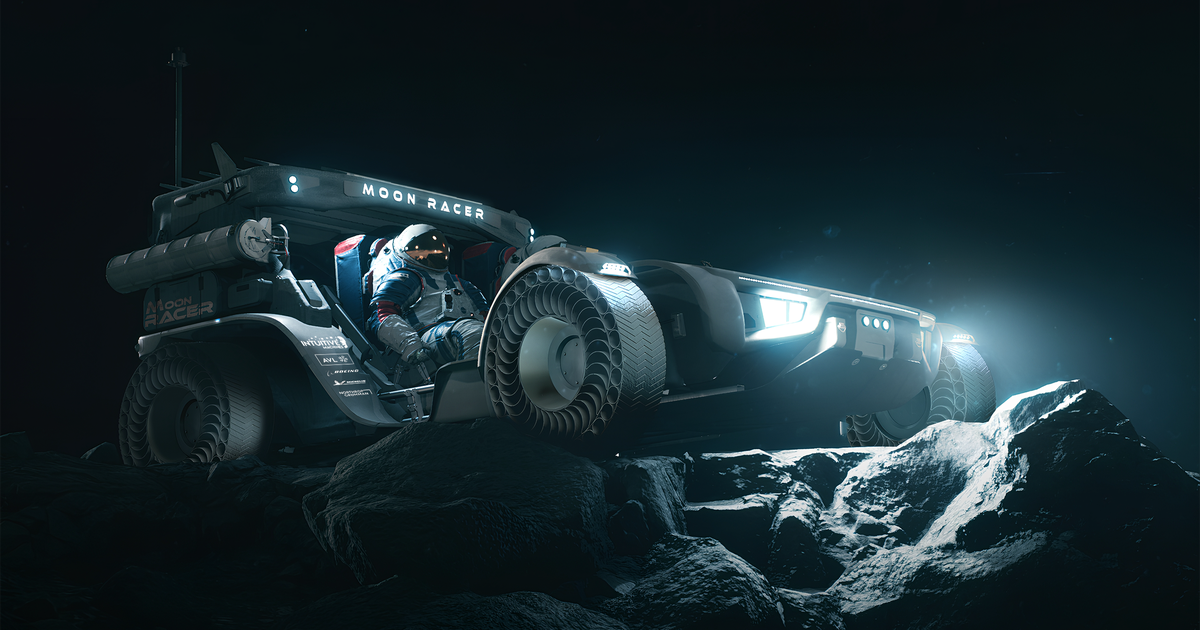1 of 24
|
On February 18, NASA's Perseverance rover will arrive on Mars.
Look at the gallery → |
This perspective of the Valles Marineris hemisphere of Mars, taken on July 9, 2013, is actually a mosaic comprising 102 images from the Viking Orbiter.
In the center is the Valles Marineris canyon system, more than 2,000 kilometers long and up to 8 kilometers deep.
(Credit: JPL-Caltech / NASA)
2 of 24
|
This self-portrait of the Curiosity Mars rover, taken in 2016, shows the rover at the Quela drill site, in the Murray Buttes area, at the bottom of Mount Sharp.
(Credit: JPL-Caltech / MSSS / NASA)
3 of 24
|
This photo of a preserved river channel on Mars was captured by an orbiting satellite.
It has overlapping colors to show different elevations.
Blue is low and yellow is high.
(Credit: NASA)
4 of 24
|
The Mars Express mission of the European Space Agency captured this image of the Korolev crater, more than 80 kilometers wide in 2018.
It is filled with icy water, near the north pole.
(Credit: ESA / DLR / FU Berlin
5 of 24
|
The Mars Reconnaissance Orbiter spacecraft used its HiRISE camera to obtain this image of an area with unusual texture on the southern floor of Gale Crater.
(Credit: NASA / JPL-Caltech / Univ. Of Arizona)
6 of 24
|
Cold lava helped preserve the footprint of the dune movement that once occurred in a southeastern region of Mars.
But it also looks like the "Star Trek" symbol.
(Credit: NASA)
7 of 24
|
Although Mars is not geologically active like Earth, the surface features have been largely shaped by the wind.
Precisely, those that have been carved by the wind like the ones in the image, called yardangs, are common on the red planet.
On the sand, the wind forms waves and small dunes.
In the thin atmosphere of Mars, the light is not scattered much, so the shadows cast by the yardangs are sharp and dark.
(Credit: JPL-Caltech / University of Arizona / NASA)
8 of 24
|
These small hematite-rich solidifications are near the Fram crater, visited by NASA's Opportunity rover in April 2004. The area shown is 3 centimeters wide.
The photo comes from the microscopic imager on Opportunity's robotic arm, with color information added from the rover's panoramic camera.
These minerals suggest that Mars had a watery past.
(Credit: JPL-Caltech / Cornell / USGS / NASA)
9 of 24
|
This image shows the seasonal flows in Valles Marineris on Mars, called Recurrent Sloping Lines, or RSLs.
These landslides on Mars appear on the slopes during spring and summer.
(Credit: NASA / JPL-Caltech / Univ. Of Arizona)
10 of 24
|
Mars is known to have sandstorms surrounding the planet.
These images taken by NASA's Mars Global Surveyor orbiter in 2001 show a drastic change in the planet's appearance as the haze generated by sandstorm activity in the south was distributed globally.
(Credit: JPL-Caltech / MSSS / NASA)
11 of 24
|
This composite image, whose horizon is the highest regions of Mount Sharp, was taken in September 2015 by NASA's Curiosity rover.
In the foreground is a long ridge filled with hematite.
A little further on is an undulating plain rich in clay minerals.
And a little further down is a multitude of rounded hills, all rich in sulfate minerals.
The changing mineralogy in these layers suggests an environment that changed early on Mars, although all involve exposure to water billions of years ago.
(Credit: JPL-Caltech / MSSS / NA
12 of 24
|
InSight's seismometer first recorded a "martemoto" in April 2019. (Credit: NASA / JPL-Caltech)
13 of 24
|
From its position atop a ridge, Opportunity recorded this 2016 image of a dust swirl on Mars traveling through the valley.
The photo also captures the rover tracks leading up the northern slope of Knudsen Ridge, which is part of the southern edge of the Marathon Valley.
(Credit: JPL-Caltech / NASA)
14 of 24
|
HiRISE captured layered deposits and a bright ice sheet at the north pole of Mars.
(Credit: JPL-Caltech / Univ. Of Arizona / NASA)
15 of 24
|
Nili Patera is a region of Mars where dunes and waves move rapidly.
HiRISE, aboard the Mars Reconnaissance Orbiter, continues to monitor this area every two months for changes on seasonal and annual timescales.
(Credit: JPL-Caltech / Univ. Of Arizona / NASA)
16 of 24
|
NASA's Curiosity rover captured its highest resolution panorama of the Martian surface in late 2019. This includes more than 1,000 images and 1.8 billion pixels.
(Credit: NASA / JPL-Caltech / MSSS)
17 of 24
|
This image, which combines data from two instruments aboard NASA's Mars Global Surveyor, shows an orbital view of the north polar region of Mars.
The ice-rich polar cap is nearly 1,000 kilometers wide, and the dark bands are deep valleys.
To the right of the center, a large canyon, Chasma Boreale, almost divides the ice sheet.
Chasma Boreale is about the length of the famous Grand Canyon of the United States and up to almost 2 kilometers deep.
(Credit: JPL-Caltech / MSSS / NASA)
18 of 24
|
A recent and drastic impact crater dominates this image taken by the HiRISE camera in November 2013. The crater spans approximately 30.5 meters and is surrounded by a large lightning blast zone.
Because the terrain where the crater formed is dusty, the recent crater appears blue in the enhanced color of the image, due to the removal of reddish dust in that area.
(Credit: JPL-Caltech / Univ. Of Arizona / NASA)
19 of 24
|
This dark mound, called Ireson Hill, is located in the Murray formation at the bottom of Mount Sharp, near a spot where NASA's Curiosity rover examined a linear sand dune in February 2017. (Credit: NASA / JPL -Caltech / MSSS
20 of 24
|
Are cookies and cream on Mars?
No, they are just polar dunes dusted with ice and sand.
(Credit: CaSSIS / ESA / Roscosmos)
21 of 24
|
The cloud in the center of this image is actually a tower of dust that occurred in 2010 and was captured by the Mars Reconnaissance Orbiter.
Blue and white clouds are water vapor.
(Credit: MSSS / JPL-Caltech / NASA)
22 of 24
|
HiRISE took this image of a kilometer-long crater in the southern hemisphere of Mars in June 2014. The crater shows frost on all its south-facing slopes in late winter, as Mars heads into spring.
(Credit: JPL-Caltech / University of Arizona / NASA)
23 of 24
|
The two largest earthquakes detected by NASA's InSight appear to have originated in a region of Mars called Cerberus Fossae.
Scientists had previously detected signs of tectonic activity here, including landslides.
This image was taken by the HiRISE camera on NASA's Mars Reconnaisance Orbiter.
(Credit: JPL-Caltech / University of Arizona / NASA)
24 of 24
|
This image is the first photograph ever taken from the surface of Mars.
It was captured on July 20, 1976 by the Viking 1 lander, shortly after it landed on the planet.
(Credit: NASA)
(CNN) ––
Perseverance, NASA's most sophisticated rover to date, is expected to land on the surface of Mars this Thursday, February 18.
He will do it around 3:55 pm Miami time.
The rover has made its journey through space since its liftoff from Cape Canaveral, Florida, in late July.
By the time it reaches Mars, Perseverance will have traveled more than 470.7 million kilometers on its way from Earth.
The Perseverance rover is NASA's first mission to search for signs of ancient life on another planet.
Just to help answer the big question: was there ever life on Mars?
The rover will explore Jezero Crater, the site of an ancient lake that existed 3.9 billion years ago, looking for microfossils in the rocks and soil at that site.
Alongside the Perseverance voyage there is an experiment to fly a helicopter, called Ingenuity, for the first time on another planet.
Here's what you need to know about what will happen this week.
How to continue the exploration of the Perseverance rover?
Unfortunately, we won't be able to see the SUV-sized rover land on the surface of Mars.
We just haven't gotten to that point yet, technologically speaking.
advertising
What is the sound of Mars?
We'll find out soon when the Perseverance rover lands
But NASA invites you to tune in to its countdown and landing commentary, which will air live beginning Thursday at 2:15 pm Miami time.
You can watch the event through NASA's public television channel, website, app, YouTube, Twitter, Facebook, LinkedIn, Twitch, Daily Motion, or THETA.TV.
For the first time, the agency will also offer a program in Spanish for landing.
During coverage of the landing, NASA's mission control team will be able to confirm whether the Perseverance rover landed safely on the surface of Mars.
Naturally, the rover has its own Twitter and Facebook accounts.
There you can review updates from the mission team from the perspective of the Perseverance rover.
And you can also bet that the Curiosity rover and the InSight lander will welcome Perseverance to his new home, the red planet.
The agency has fun ways to be part of the countdown excitement.
Among them, taking photos and activities for children and students.
You can also follow each step of the Perseverance rover landing in a NASA interactive or even sign up for a virtual landing experience.
Perseverance rover to land on Mars along with orbiters 0:51
"If there's one thing we know, it's that landing on Mars is never easy," explained Marc Etkind, NASA's associate communications administrator. "But, being NASA's fifth rover on Mars, Perseverance has a pedigree of engineering and an extraordinary mission team, ”he added.
Just a few weeks after landing, if all goes according to plan, the spacecraft's cameras and microphones will show the rover's perspective for the first time.
Landing of the Perseverance rover on Mars: "7 minutes of terror"
If successful, the Perseverance rover will star in NASA's ninth landing on Mars.
But first, he has to go through the infamous "seven minutes of terror."
The one-way time it takes for radio signals to travel from Earth to Mars is about 10.5 minutes.
Which means that the seven minutes it takes for the spacecraft to land on Mars will elapse without any help or intervention from NASA teams on Earth.
Ground crews tell the spacecraft when to begin the EDL (entry, descent and landing) stage.
From there, the spacecraft takes over and mission control begins an agonizing wait.
The Perseverance rover is the heaviest NASA has tried to land with so far - over a metric ton.
The spacecraft hits the upper part of the atmosphere of Mars moving at 19,312 kilometers per hour.
And it has to slow down to 0 kilometers per hour seven minutes later, when the vehicle lands gently on the surface.
This illustration shows the events that occur during the final minutes of NASA's Perseverance rover landing on the Martian surface.
The spacecraft's heat shield will withstand a heating peak of 1,298.8 degrees Celsius, 75 seconds after entering the atmosphere.
The Persevering rover aims to reach a 45-kilometer-wide ancient lake bed and a river delta.
So far it is the most challenging landing site for a NASA spacecraft on Mars.
Rather than being flat and smooth, the small landing site is littered with sand dunes, sheer cliffs, rocks, and small craters.
The ship has two upgrades, called Range Trigger and Terrain-Relative Navigation, to navigate this difficult and dangerous site.
The Range Trigger will tell the 21.48 meter wide parachute when to deploy based on the spacecraft's position 240 seconds after entering the atmosphere.
Once the parachute is deployed, the heat shield will come off.
Bacteria from Earth could potentially be used to extract minerals on the Moon or on Mars
The Perseverance rover's Terrain-Relative Navigation acts as a second brain.
In fact, it uses cameras to take pictures of the ground as it approaches quickly and determines the safest place to land.
This update can change the landing site up to 609 meters, according to NASA.
The rear shell and the parachute will separate after the heat shield detaches.
What will happen when the spacecraft is 2 kilometers above the Martian surface.
The engines for the Mars landing, which include eight retro rockets, will fire to slow the descent from 305.7 kilometers per hour to about 2.7 kilometers per hour.
Later, the famous maneuver of the aerial crane that landed the Curiosity rover will occur.
Nylon cords will lower the vehicle 7.62 meters below the descent stage.
After the Perseverance rover lands on the surface of Mars, the cables will detach and the descent stage will fly and land at a safe distance.
The mission: what will the rover do?
Once the rover has landed, Perseverance's two-year mission will begin.
First, you will go through an "out" period to make sure you are ready.
How to see NASA landing on Mars in Spanish?
0:35
Perseverance will search for evidence of ancient life.
It will study the climate and geology of Mars and collect samples that will eventually return to Earth in the 2030s.
For that reason, the Perseverance rover is also the cleanest machine ever sent to Mars.
It is designed not to contaminate Martian samples with microbes from Earth that could provide a false reading.
The Jezero Crater was chosen as the home of Perseverance, because billions of years ago the basin was the site of a lake and a river delta.
The rocks and soil in this basin could provide fossilized evidence of past microbial life.
As well as more information about what ancient Mars was like.
'Perseverance's sophisticated scientific instruments will not only aid in the search for fossilized microbial life.
They will also expand our knowledge of Martian geology and its past, present and future, ”Ken Farley said in a statement.
Farley is one of the scientists on the Mars 2020 project.
This mosaic of images collected by the Mars Reconnaissance Orbiter shows a possible route that the Perseverance rover could take through Jezero crater.
The path the Perseverance rover will traverse is approximately 15 miles long, an "epic journey" that will take years, Farley said.
However, what scientists might discover about Mars is worth the trip.
To achieve its goals, the Perseverance will drive at 0.16 kilometers per hour, three times faster than previous rovers.
The rover also carries instruments that could aid further exploration on Mars in the future.
Among them is MOXIE, the Mars In-Situ Oxygen Resource Utilization Experiment.
This experiment, about the size of a car battery, will attempt to convert Martian carbon dioxide into oxygen.
The countdown of an epic mission to Mars begins 7:38
This could not only help NASA scientists learn how to produce rocket fuel on Mars, but also oxygen that could be used during future human exploration of the red planet.
Ingenuity, the first helicopter on another planet
The Perseverance rover does not travel to Mars on its own.
In the exploration is Ingenuity, which will be the first helicopter to fly over another planet.
After landing, the rover will also find a nice, flat surface to drop the Ingenuity helicopter.
So you have a place to use as a helipad for your possible five test flights over a 30-day period.
This will occur within the first 50 to 90 suns, or Martian days, of the mission.
Perseverance will be able to observe Ingenuity's flight.
Once Ingenuity settles to the surface, the Perseverance will drive to safety at a distance.
At that point, he will use his cameras to observe Ingenuity's flight.
Ingenuity weighs just 1.8 kilograms and has four carbon fiber blades, solar cells and batteries.
Mars has an incredibly thin atmosphere.
Because of this, the Ingenuity design had to be lightweight and include rotors larger and faster than those of typical helicopters on Earth to lift it into the air.
If Ingenuity is successful, it could pave the way for more advanced robotic aircraft to be used in future missions to Mars, both robotic and human, according to NASA.


